Posted by · 1 Comment
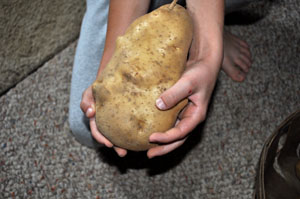 From year to year we have “volunteer” plants come up. They surprise us both with their locale (maybe an errant seed dropped by a bird) and species that it appears has wintered over.
From year to year we have “volunteer” plants come up. They surprise us both with their locale (maybe an errant seed dropped by a bird) and species that it appears has wintered over.
This year, among the volunteer crop, was this particular Superior potato plant. 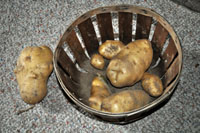 The potatoes in the basket would be a somewhat “normal” yield for a plant but what makes this extraordinary is the fact that the whopper that Natalie is holding was also produced by the same plant!
The potatoes in the basket would be a somewhat “normal” yield for a plant but what makes this extraordinary is the fact that the whopper that Natalie is holding was also produced by the same plant!
Other volunteer seeds have produced sunflowers, tomatoes, various annual flowers, and a variety of squash/pumpkin/gourds. They’re always a treat to find in the garden because they’ll be slightly ahead in growth of what you’ve planted by seed that year.
When we first moved in, I had David rip up a large area at the back of the house for my flower beds. This year will mark the first year we did not have a volunteer tomato crop magically appearing there, in and amongst the flowers. He tended to think it could’ve been the site of an outhouse (sorry for those who can’t “stomach” the thought of life before plumbing). The more I think about it, he’s probably right.
As far as the gigantic potato-bearing plant goes? A chunk of potato was, inadvertently, left in the ground from last year and just sprouted. And, boy, did it sprout?!

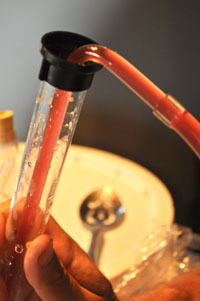 from the “must.”
from the “must.”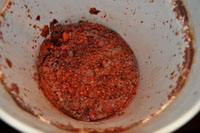
 After I took the photo of the yeast bubbles, we added handfuls of marbles to bring the liquid up into neck of the carboy (you want as little interaction between liquid and air as possible).
After I took the photo of the yeast bubbles, we added handfuls of marbles to bring the liquid up into neck of the carboy (you want as little interaction between liquid and air as possible).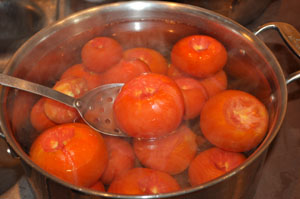
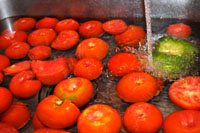 I needed it to fill out the weight of the tomatoes required in my barbeque sauce recipe. No one will ever know; shhhhh! Don’t tell…
I needed it to fill out the weight of the tomatoes required in my barbeque sauce recipe. No one will ever know; shhhhh! Don’t tell…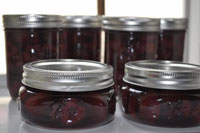 When you can fruits or veggies, you hope for the best…the best quality, the best “seal,” the best (and prettiest) presentation or “pack.”
When you can fruits or veggies, you hope for the best…the best quality, the best “seal,” the best (and prettiest) presentation or “pack.”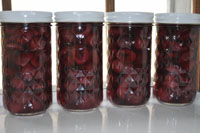 Sometimes, everything comes together on the very first go-round – like the Ball recipe for Spirited Cherries I attempted for the first time yesterday.
Sometimes, everything comes together on the very first go-round – like the Ball recipe for Spirited Cherries I attempted for the first time yesterday.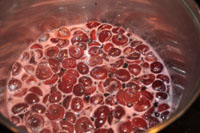 So very delicious…and simple…and pretty…that I just had to do a second batch immediately! These will be a perfect addition to a main course or dessert, especially in the winter when you seek out those bolder flavors.
So very delicious…and simple…and pretty…that I just had to do a second batch immediately! These will be a perfect addition to a main course or dessert, especially in the winter when you seek out those bolder flavors.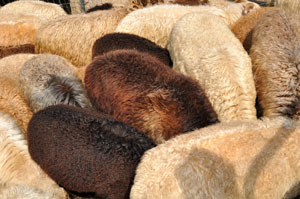 The Navajo-Churro wool is beautiful! Just look at the colors of the sheep I was able to photograph before everyone came charging into the barn last week. I’ve been fascinated by their coats since we first purchased Reese and her twins, Lovey and Clara (Clara Barton Angel Of The Battlefield, so named by my history-loving son) years ago.
The Navajo-Churro wool is beautiful! Just look at the colors of the sheep I was able to photograph before everyone came charging into the barn last week. I’ve been fascinated by their coats since we first purchased Reese and her twins, Lovey and Clara (Clara Barton Angel Of The Battlefield, so named by my history-loving son) years ago.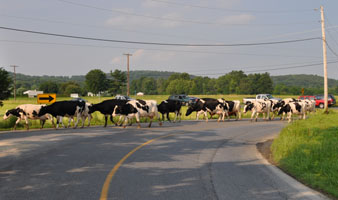 Every morning, a local dairy farmer leads his herd down the road to another pasture and then collects them in the evening to milk. If you time it just right, you get to watch the march—it’s special—only this time, it caught the school bus. I bet if Bob has to call the transportation office to explain the tardiness, not much of an excuse is needed.
Every morning, a local dairy farmer leads his herd down the road to another pasture and then collects them in the evening to milk. If you time it just right, you get to watch the march—it’s special—only this time, it caught the school bus. I bet if Bob has to call the transportation office to explain the tardiness, not much of an excuse is needed.  I wander around the yard and barn capturing images I think would make nice accompaniments to blog entries and snapped this one of the chair in my flower bed.
I wander around the yard and barn capturing images I think would make nice accompaniments to blog entries and snapped this one of the chair in my flower bed. 
